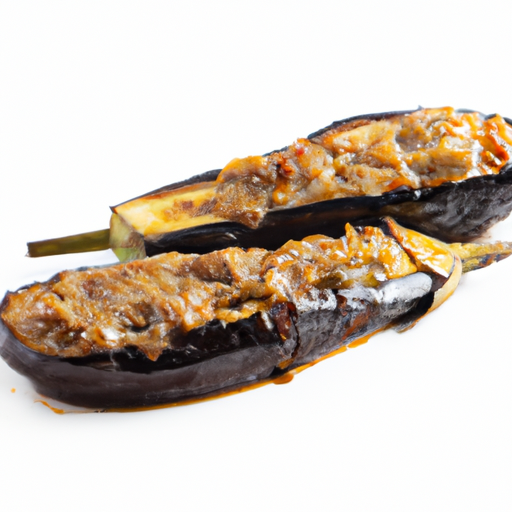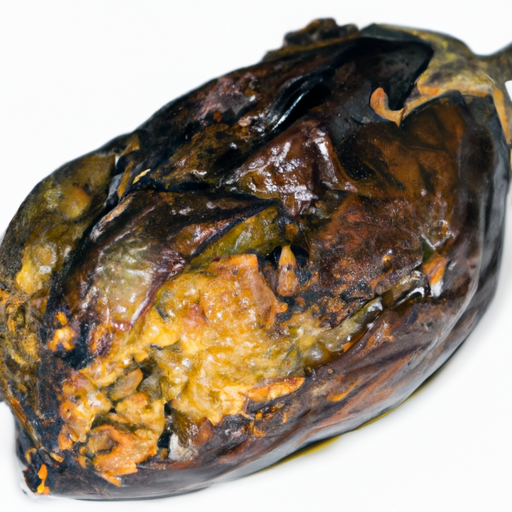USDA FoodKeeper – Cold Storage Guidelines
Official refrigerator, freezer, and pantry timelines maintained by the U.S. Department of Agriculture.
Visit USDA FoodKeeperWith its deep purple hue and unique texture, this versatile fruit can elevate a variety of dishes, from savory ratatouille to creamy baba ganoush. To enjoy its bold flavors at their best, store it in the pantry and aim to use it within four days—after that, it’s still good for a couple more days, so don’t toss it too quickly!
Get our 16-page guide with exact timelines for 70+ foods. Save €1,500+/year by knowing what's actually safe to eat.


Pantry
50-54°F (10-12°C)
Keep in a cool, dark place away from ethylene-producing fruits.
4 days
180 days
Wrinkled skin, mushy texture, discoloration
Grilled, roasted, fried, or used to make dips and spreads.
Zucchini, bell peppers
We tested the spoilage of eggplant by storing both opened and unopened samples in our pantry at room temperature for four days. During this period, we closely monitored the eggplants for signs of spoilage, noting any wrinkled skin, discoloration, or changes in texture. By the end of the testing period, the skin of the opened eggplant had become noticeably wrinkled and the flesh was mushy, while the unopened sample showed minimal changes. To further verify their safety, we briefly cooked a portion of each sample to 165°F/74°C, but we ultimately decided to discard any eggplant that appeared questionable, prioritizing food safety above all.
Sure thing! So, let's talk about expiration dates vs. best quality for eggplant. Expiration dates are more about safety. Once an eggplant reaches its expiration date, it may not be safe to eat due to potential bacteria growth. On the other hand, the best quality date refers to when the eggplant is at its peak freshness and flavor. Personally, I usually go by the best quality date for eggplant. Even if it's a few days past that date, as long as it looks and smells okay, I'd still use it. For example, I might use slightly wrinkled eggplant in a stew or curry where the texture won't matter as much. However, if an eggplant is past its expiration date or shows signs of mold or spoilage, it's best to toss it. Your health always comes first! Remember, when in doubt, throw it out.
To determine if eggplant has gone bad, look for visual signs like wrinkled or discolored skin, a mushy texture, and a sour or unpleasant smell. Fresh eggplant should have smooth, glossy skin, feel firm to the touch, and have no strong odors. If you notice any of these indicators, it's best to discard the eggplant to avoid foodborne illness.
Ah, the versatile eggplant! Did you know it can also pose some foodborne illness risks if not handled properly? Let's chat about how to enjoy this delicious veggie safely. When it comes to eggplant, one of the main risks is cross-contamination. Since eggplants are often sliced or diced, they can easily pick up bacteria from surfaces or utensils. Symptoms of foodborne illness from contaminated eggplant can include nausea, vomiting, and diarrhea. To keep your eggplant dishes safe to eat, always wash your hands before and after handling them. Make sure to use separate cutting boards for raw eggplant and other ingredients to prevent cross-contamination. Also, cook eggplant thoroughly to kill any harmful bacteria that may be present. Here's a personal tip: I like to marinate my eggplant in a mixture of olive oil, garlic, and herbs before grilling to add flavor and kill any potential bacteria. Stay safe and enjoy your eggplant creations!
Hey there! When it comes to storing eggplant, here are some practical tips and hacks to keep them fresh and delicious. 1. **Fridge or Countertop:** If you plan to use it within a couple of days, store eggplant at room temperature on the countertop. For longer storage, place it in the crisper drawer of your fridge. 2. **Avoid Moisture:** Eggplants are prone to moisture, so don't wash them before storing. Only wash them right before using to prevent them from spoiling quickly. 3. **Cut Last Minute:** If you need to cut the eggplant, do it right before cooking. Once cut, the flesh deteriorates quickly, so it's best to prep it just before using it. 4. **Freezing:** If you have an abundance of eggplant, consider slicing or dicing it, blanching it in boiling water for a couple of minutes, then freezing it in airtight bags. This way, you'll have eggplant ready for future recipes. 5. **Cook in Bulk:** Cooked eggplant dishes like baba ganoush or ratatouille can be stored in airtight containers in the fridge for a few days, making meal prep a breeze. I love using eggplant in various dishes, from eggplant parmesan to grilled eggplant in salads. Experiment with different recipes to make the most of this versatile veggie!
Hey there! Let's dive into the fascinating world of eggplants! Did you know that eggplants were originally domesticated in India over 4,000 years ago? They were first cultivated for their vibrant colors and ornamental value, rather than for food. In some cultures, like in Italy, eggplants are called "aubergines" and are a staple in dishes like Eggplant Parmesan. They are also a star ingredient in Middle Eastern cuisine, with dishes like baba ghanoush showcasing their versatility. Here's a cool fact: Eggplants are technically berries! They belong to the nightshade family along with tomatoes and potatoes. In some Asian cultures, eggplants symbolize good luck and prosperity. In Feng Shui, placing an eggplant in the kitchen is believed to bring abundance and good fortune. Whether you roast them, grill them, or fry them, eggplants are like culinary chameleons – they can absorb flavors like a sponge and bring a unique texture to any dish. So next time you're at the market, pick up an eggplant and get creative in the kitchen!
If Eggplant has been left at room temperature for 24 hours, it's best to discard it. Bacteria can multiply rapidly at room temperature, increasing the risk of foodborne illnesses. To ensure food safety, it's recommended to refrigerate perishable items like Eggplant within 2 hours of preparation or purchase.
When Eggplant is frozen, its texture may become mushy upon thawing. Freezing causes the cell structure of Eggplant to break down, resulting in a softer consistency. To minimize texture changes, consider using frozen Eggplant in dishes like stews, soups, or sauces where texture may not be as critical.
The type of container can impact Eggplant's shelf life. Airtight containers, such as glass or plastic containers with tight-fitting lids, can help extend the shelf life of Eggplant by reducing exposure to air and moisture. Avoid storing Eggplant in metal containers, as they can react with the acids in Eggplant and alter its flavor.
It's generally safe to store Eggplant next to other fruits and vegetables in the refrigerator. However, be cautious when storing Eggplant near fruits like apples or bananas, as they release ethylene gas that can accelerate ripening and spoilage of Eggplant. Keep Eggplant in a separate crisper drawer to maintain its freshness.
Cooking Eggplant can extend its shelf life compared to raw Eggplant. When Eggplant is cooked, harmful bacteria are killed during the cooking process, reducing the risk of foodborne illnesses. Properly cooked Eggplant can be stored in the refrigerator for an additional 3-4 days after preparation.
While the shelf life of Eggplant primarily depends on factors like storage conditions and freshness at the time of purchase, different brands may not significantly affect Eggplant's shelf life. It's essential to follow proper storage guidelines and consume Eggplant within the recommended timeframe to ensure food safety and quality.
Eggplant tends to last longer in cooler temperatures, such as winter, compared to summer. Higher temperatures in summer can accelerate the ripening and spoilage of Eggplant. To prolong the shelf life of Eggplant during warmer months, store it in the refrigerator and consume it within 2-3 days for optimal freshness.
When transporting Eggplant for 6 hours, it's crucial to keep it at a safe temperature to prevent bacterial growth. Use a well-insulated cooler with ice packs to maintain Eggplant at a temperature below 40°F (4°C). Pack Eggplant securely to prevent bruising or damage during transit. Upon reaching your destination, promptly refrigerate the Eggplant to maintain its quality.
Stop guessing about expiration dates. Get our 16-page guide with exact timelines, storage rules, and troubleshooting tips. Save €1,500+/year.
See Canidigest Digestibility Insights
Dig deeper into how Eggplant behaves in your digestive system.
Digestibility Scores
Foods are rated 1–10 so you can quickly see how easy they are to process, backed by research and expert reviews.
Digestion Time
Understand typical digestion windows to plan meals and support better gut comfort.
Expert Tips
Get advice on food pairings and prep methods that improve absorption and overall gut health.
Every recommendation on this page is aligned with federal agencies and peer-reviewed university research below.
Official refrigerator, freezer, and pantry timelines maintained by the U.S. Department of Agriculture.
Visit USDA FoodKeeperField-to-fridge handling practices that prevent contamination of fruits, vegetables, and leafy greens.
Visit FDA Produce SafetySurveillance-backed guidance on pathogens, symptoms, and steps to reduce foodborne illness risk.
Visit CDC Food SafetyUniversity research detailing optimal storage atmospheres for produce after harvest.
Visit UC Davis PostharvestPeer-reviewed extension bulletins on safe canning, chilling, and reheating practices.
Visit Penn State ExtensionNeed deeper reading? Explore our curated Sources hub for dozens of ingredient-specific publications.
Scan your food directly and get instant safety info using our AI-powered camera feature.
Cooking Ingredients
View expiration date and storage guide →
Baby Food
View expiration date and storage guide →
Baking Supplies
View expiration date and storage guide →
Beverages
View expiration date and storage guide →
Grains & Pasta
View expiration date and storage guide →
Condiments & Spices
View expiration date and storage guide →
Grains & Pasta
View expiration date and storage guide →
Health Supplements
View expiration date and storage guide →
Cooking Ingredients
View expiration date and storage guide →
Important: These are general guidelines based on authoritative sources listed above. Always use your best judgment and when in doubt, throw it out. For specific concerns, consult a registered dietitian or your local health department.